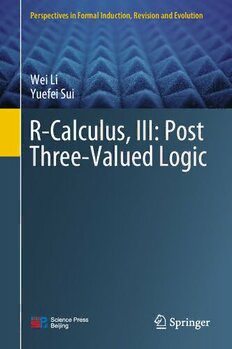Table Of ContentPerspectives in Formal Induction, Revision and Evolution
Wei Li
Yuefei Sui
R-Calculus, III: Post
Three-Valued Logic
Perspectives in Formal Induction, Revision
and Evolution
Editor-in-Chief
WeiLi,Beijing,China
SeriesEditors
JieLuo,Beijing,China
YuefeiSui,InstituteofComputingTechnology,ChineseAcademyofSciences,
Beijing,China
PerspectivesinFormalInduction,RevisionandEvolutionisabookseriesfocusing
onthelogicsusedincomputerscienceandartificialintelligence,includingbutnot
limited to formal induction, revision and evolution. It covers the fields of formal
representation, deduction, and theories or meta-theories of induction, revision and
evolution,wheretheinductionisofthefirstlevel,therevisionisofthesecondlevel,
andtheevolutionisofthethirdlevel,sincetheinductionisattheformulastratum,
therevisionisatthetheorystratum,andtheevolutionisatthelogicstratum.
Inhisbook“TheLogicofScientificDiscovery”,KarlPopperarguesthatascien-
tificdiscoveryconsistsofconjecture,theory,refutation,andrevision.Somescientific
philosophersdonotbelievethatareasonableconjecturecancomefrominduction.
Hence, induction, revision and evolution have become a new territory for formal
exploration. Focusing on this challenge, the perspective of this book series differs
fromthatoftraditionallogics,whichconcernsconceptsanddeduction.
The series welcomes proposals for textbooks, research monographs, and edited
volumes,andwillbeusefulforallresearchers,graduatestudents,andprofessionals
interestedinthefield.
·
Wei Li Yuefei Sui
R-Calculus, III: Post
Three-Valued Logic
WeiLi YuefeiSui
BeihangUniversity InstituteofComputingTechnology
Beijing,China ChineseAcademyofSciences
Beijing,China
ISSN 2731-3689 ISSN 2731-3697 (electronic)
PerspectivesinFormalInduction,RevisionandEvolution
ISBN 978-981-19-4269-3 ISBN 978-981-19-4270-9 (eBook)
https://doi.org/10.1007/978-981-19-4270-9
JointlypublishedwithSciencePress
TheprinteditionisnotforsaleinChina(Mainland).CustomersfromChina(Mainland)pleaseorderthe
printbookfrom:SciencePress.
©SciencePress2022
Thisworkissubjecttocopyright.AllrightsaresolelyandexclusivelylicensedbythePublisher,whether
thewholeorpartofthematerialisconcerned,specificallytherightsofreprinting,reuseofillustrations,
recitation,broadcasting,reproductiononmicrofilmsorinanyotherphysicalway,andtransmissionor
informationstorageandretrieval,electronicadaptation,computersoftware,orbysimilarordissimilar
methodologynowknownorhereafterdeveloped.
Theuseofgeneraldescriptivenames,registerednames,trademarks,servicemarks,etc.inthispublication
doesnotimply,evenintheabsenceofaspecificstatement,thatsuchnamesareexemptfromtherelevant
protectivelawsandregulationsandthereforefreeforgeneraluse.
Thepublishers,theauthors,andtheeditorsaresafetoassumethattheadviceandinformationinthisbook
arebelievedtobetrueandaccurateatthedateofpublication.Neitherthepublishersnortheauthorsor
theeditorsgiveawarranty,expressedorimplied,withrespecttothematerialcontainedhereinorforany
errorsoromissionsthatmayhavebeenmade.Thepublishersremainneutralwithregardtojurisdictional
claimsinpublishedmapsandinstitutionalaffiliations.
ThisSpringerimprintispublishedbytheregisteredcompanySpringerNatureSingaporePteLtd.
The registered company address is: 152 Beach Road, #21-01/04 Gateway East, Singapore 189721,
Singapore
Preface to the Series
Classicalmathematicallogics(propositionallogic,first-orderlogicandmodallogic)
andappliedlogics(temporallogic,dynamiclogic,situationcalculus,etc.)concern
deduction, a logical process from universal statements to particular statements.
Descriptionlogicsconcernconceptswhichanddeductioncomposeofgenerallogics.
Induction and belief revision are the topics of general logics and philosoph-
icallogics,andevolutionisanewresearchareaincomputerscience.Toformalize
induction,revisionandevolutionisagoalofthisseries.
Revisionisomnipresentinsciences.Anewtheoryusuallyisarevisionofanold
theory or several old theories. Copernicus’ heliocentric theory is a revision of the
Tychonicsystem;thetheoryofrelativityisarevisionoftheclassicaltheoryofmove-
ment;thequantumtheoryisarevisionofclassicalmechanics;etc.TheAGMpostu-
lates is a set of conditions a reasonable revision operator should satisfy. Professor
Li proposed a calculus for first-order logic, called R-calculus, which is sound and
completewithrespecttomaximalconsistentsubsets.R-calculushasseveralvariants
which can be used in other logics, such as nonmonotonic logics, can propose new
problemsintheclassicallogics,andwillbeusedinbigdata.
Popper proposed in his book The Logic of Scientific Discovery that a scien-
tificdiscoveryconsistsoffouraspects:conjecture,theory,refutation,andrevision.
Somescientificphilosophersrefutedthatareasonableconjectureshouldcomefrom
induction. Hence, induction, revision and evolution becomes a new territory to be
discoveredinaformalway.
An induction process is from particular statements to universal statements. A
typical example is the mathematical induction, which is a set of nontrivial axioms
in Peano arithmetic which makes Peano arithmetic incomplete with respect to the
standardmodelofPeanoarithmetic.Alogicforinductionisneededtoguidedata-
mininginartificialintelligence.Data-miningisacanonicalinductionprocess,which
minesrulesfromdata.
In biology, Evolution is change in the heritable traits of biological populations
oversuccessivegenerations.Insciences,Darwin’sevolutiontheoryisanevolutionof
intuitivetheoriesofplantsandanimals.Inlogic,anevolutionisageneratingprocess
ofcombiningtwologicsintoanewlogic,wherethenewlogicshouldhavethetraits
v
vi PrefacetotheSeries
oftwologics.Hence,weshoulddefinethecorrespondingheritabletraitsoflogics,
sets of logics, and sequences of logics. Simply speaking, predicate modal logic is
an evolution of propositional modal logic and predicate logic, and there are many
new problems in predicate modal logic to be solved, such as the constant domain
semanticsandthevariantdomainsemantics,etc.
The series should focus on formal representation, deduction, theories or meta-
theoriesofinduction,revisionandevolution,wheretheinductionisofthefirstlevel,
the revision is of the second level, and the evolution is of the third level, because
theinductionisattheformulastratum,therevisionisatthetheorystratum,andthe
evolutionisatthelogicstratum.
Thebooksintheseriesdifferinlevel:someareoverviewsandsomehighlyspecial-
ized.Here,thebooksofoverviewsareforundergraduatedstudents,andthehighly
specializedonesareforgraduatedstudentsandresearchersincomputerscienceand
mathematicallogic.
Beijing,China LiWei
October2016 LuoJie
SongFangming
SuiYuefei
WangJu
ZhuWujia
Preface
Post three-valued logic has sound and complete tableau proof systems, Gentzen
deductionsystemsforsequentsandGentzen-typeddeductionsystemsformultise-
quents,whichotherthree-valuedlogicsdonothave.
ForPostthree-valuedlogictherearedeductionsystemsatdifferentlevels:atthe
theory level, at the sequent level and at the multisequent level. At each level, the
validityhascomplementaryvalidityanddualvalidity,andcorrespondinglythereare
sound and complete deduction systems for validity, co-validity and dual validity,
respectively.
Correspondingly, there are R-calculi at the three levels. At each level, an R-
calculushasacomplementaryR-calculusandadualR-calculus,whichareproved
to be sound and complete. Therefore, we have the following table for all levels of
deductionsystemsandR-calculi:
Deduction Dualdeduction R-calculus DualR-calculus
Theories T*[=] S*[(cid:2)=] R*[=] Q*[(cid:2)=]
T ((cid:2)=) S (=) R ((cid:2)=) Q (=)
* * * *
Sequents G*[(cid:2)=V=] F*[=V(cid:2)=] E*[(cid:2)=V=] D*[=V(cid:2)=]
G*(=V(cid:2)=) F*((cid:2)=V=) E*(=V(cid:2)=) D*((cid:2)=V=)
Multisequents M= L(cid:2)= K= J(cid:2)=
M(cid:2)= L= K(cid:2)= J=
where ∗ ∈ {t,m,f}, [=] denotes the revision preserving validity and (=) denotes
therevisionpreservingsatisfiability.
vii
viii Preface
Other kinds of multisequents are considered. For uniform quantifiers, there are
eightkindsofvaliditiesandR-calculi:
M= , L(cid:2)= , K= , J(cid:2)=
QQQ QQQ QQQ QQQ
MQQQ, LQQQ, KQQQ, JQQQ
(cid:2)= = (cid:2)= =
Asquantifiersarenotuniform,therearemanykindsofvaliditiesandR-calculi:
M= , L(cid:2)= , K= , J(cid:2)=
Q1Q2Q3 Q1Q2Q3 Q1Q2Q3 Q1Q2Q3
M(cid:2)=Q1Q2Q3, L=Q1Q2Q3, K(cid:2)=Q1Q2Q3, J=Q1Q2Q3
ThesedeductionsystemsandR-calculiwillbeprovedtobesoundandcomplete.
Beijing,China WeiLi
October2021 YuefeiSui
Contents
1 Introduction .................................................. 1
1.1 Three-ValuedLogics ...................................... 1
1.2 DeductionSystems ....................................... 2
1.3 R-Calculi ............................................... 4
1.4 More ................................................... 8
1.5 BasicDefinitions ......................................... 10
1.5.1 PostThree-ValuedLogic ........................... 10
1.5.2 PostThree-ValuedDescriptionLogic ................ 15
1.5.3 Remarks ......................................... 23
1.6 TypesofDeductionRules ................................. 25
1.7 Notations ............................................... 32
References .................................................... 33
2 Many-PlacedSequents ......................................... 35
2.1 Zach’sTheorem .......................................... 36
2.2 AnalysisofZach’sTheorem ............................... 40
2.3 TableauProofSystems .................................... 43
2.3.1 TableauProofSystemTt .......................... 43
2.3.2 TableauProofSystemTm .......................... 44
2.3.3 TableauProofSystemTf .......................... 45
2.4 IncompletenessofDeductionSystemT(cid:5)(cid:5) ..................... 46
References .................................................... 47
3 ModalizedThree-ValuedLogics ................................ 49
3.1 BochvarThree-ValuedLogic ............................... 49
3.1.1 BasicDefinitions ................................. 49
3.1.2 MultisequentDeductionSystemMb ................. 51
3.2 KleeneThree-ValuedLogic ................................ 54
3.2.1 BasicDefinitions ................................. 54
3.2.2 GentzenDeductionSystemGk ..................... 55
ix

